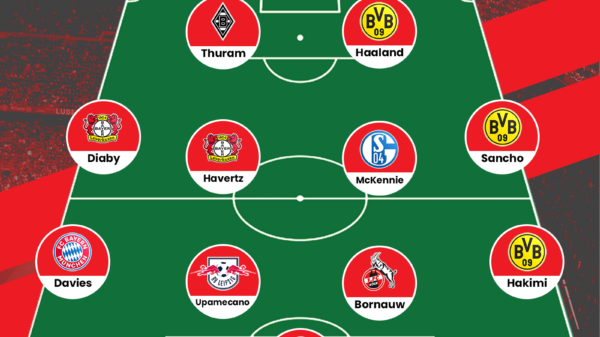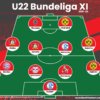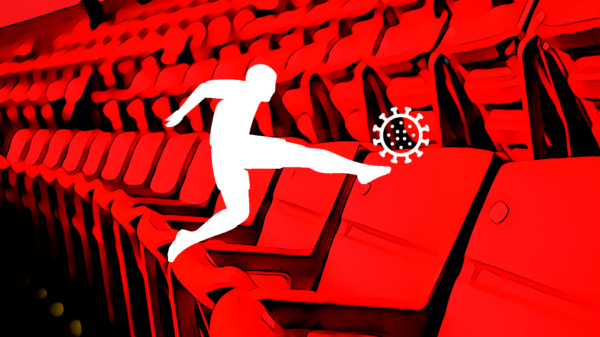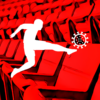Last season’s top two met in German football’s curtain raiser and if this match is anything to go by Bayern could finally have some serious competition for domestic honours in the upcoming season. Despite the match being somewhat midway through the pre-season preparations of both sides it kicked off at a high tempo and ended in similar fashion with an equaliser right at the death.
Line-Ups
On paper Bayern appeared to be set up in a basic 4-2-3-1 formation however it was never going to be that simple with Pep Guardiola as manager. Instead Bayern played most of the match in an asymmetric 3-3-4 formation with Lahm and Alaba in hybrid centre-back/wing-back positions.
Wolfsburg lined up in 4-2-3-1 with key man Kevin De Bruyne occupying the attacking midfield position behind Dost and in front of the double pivot partnership of Guilavogui and Maximilian Arnold.
Wolfsburg (4-2-3-1): 28. Koen Casteels// Vieirinha, Naldo, Klose, Rodriguez// Guilavogui, Arnold// Caligiuri, De Bruyne, Perisic// Dost
Bayern (3-3-4): Neuer// Boateng, Benatia, Alaba// Lahm, Alonso, Thiago// Robben, Muller, Lewandowsi, Costa
Substitutions:
Andre Schurrle for Caligiuri (‘63); Max Kruse for Perisic (‘70); Nicklas Bendtner for Bas Dost (‘70)
Rafinha for Lewandowski (‘72); Arturo Vidal for Thiago (‘74); Mario Gotze for Thomas Muller (‘84)
Bayern asymmetry in build up
Bayern’s positioning when building from the back was interesting, the Lahm-Alaba axis and Thiago’s positioning particularly so. Alaba would drift inside to make a back three while Lahm would push on to join the midfield line adding width but also reacting to Robben’s positioning to ensure they rarely occupied the same vertical line. Along with the back three Alonso would drop in to create a diamond shape as Benatia dropped behind the other centre backs.
During Bayern’s build-up the centre of the pitch was often vacated due to the movements of the central players aimed at creating wide overloads. Alonso would drop in to assist progression of the possession, Thiago would move towards the left flank almost operating as a left wing back. Muller was oriented towards the right half space and Lewandowski occupied the space between Wolfsburg’s right centre back and right back.
Qualitative and quantitative superiority
A major part of Bayern’s attacking strategy was to exploit the 1v1 capabilities (qualitative superiority) of Arjen Robben and Douglas Costa. Guardiola employed a few mechanisms in order to isolate Wolfsburg’s full-backs against Bayern’s wingers. One of these was simply to overload one side of the pitch often the right with Boateng, Lahm, Robben and Muller and then utilise a long diagonal pass to the other flank. Of course overloading one side of the pitch would draw the opponent to that side to defend which would naturally leave their opposite flank understaffed. This would leave either Costa or Robben in space to control the long pass and beat the full-back tasked with marking them from there they could either supply dangerous crosses or go directly for goal. Douglas Costa in particular had the beating of Vieirinha (who is actually a winger) all game and it was one of these moments that led to Bayern’s opener.
Another mechanism used to isolate Wolfsburg’s full backs 1v1 against Costa and Robben was the positioning of the central players. On the left Lewandowski would occupy Naldo, and Thiago would either move inwards to draw Caligiuri inwards and vacate the flank, or move towards the left and opening up a central passing lane to Costa who would move inwards. On the right Muller would often attract Arnold’s attention while Lahm distracted Perisic leaving Robben 1v1 against Rodriguez. Lahm’s movements were a trigger for Bayern’s patterns of play, when Lahm went wide Robben came infield to combine with team-mates however when Lahm came inside Robben would receive the ball on the flank to take Rodriguez on.
Defensive systems
There were a number of similarities in the defensive systems used by both teams. Wolfsburg defended in a 4-3-3/4-4-2 mid-block system with a high degree of horizontal compaction. This was in order to force Bayern to play in wide areas where less rotational possibilities exist making their play more predictable, they could also isolate Bayern’s possession from the centre by building a wide block. They did not manage to do so effectively due to the numerical superiority Bayern established in these areas which of course meant Bayern could keep possession in these areas with relative ease. Wolfsburg’s front line were mostly passive instead of pressing they chose to fill positions that would make vertical passes more difficult. Despite the passive front line Wolfsburg’s defensive line was quite high which obviously meant there was relatively little space between the lines of their defence (vertical compactness). Interestingly Wolfsburg often avoided counterpressing in defensive transitions, instead the forward players dropped into their usual out-of-possession positions and offered Bayern backwards passes as the paths of least resistance.
Bayern defended in a 4-1-4-1 shape which was only different to Wolfsburg’s 4-3-3 by virtue of the wide players dropping in alongside the midfield players. As always Bayern’s defensive line was extremely high with Lewandowski, Robben and Costa taking up positions to aid Bayern’s defensive shape and making them difficult to play through. This meant that passes from Wolfsburg’s centre backs were usually directed to wide areas where they were more vulnerable to turnovers of possession. This was a major pressing trigger for Bayern, Lewandowski would then join the wide player on that side in pressing intensely to regain the ball, this was very effective in the first half but far less so in the second.
Second half changes
In the first half Wolfsburg wasted several attacks due to a lack of patience, they spurned chances to create genuine openings, instead opting to chance their arm from range. This was partially understandable given that they experienced large spells without any meaningful possession. However in the second half Wolfsburg’s attacks became more dangerous as the attacking midfield players moved inwards to combine and retain possession in advanced central areas. These movements opened up the flanks for their attack minded full backs to supply crosses, better deliveries in these situations would have caused Bayern far more problems. In all likelihood this was a result of Wolfsburg falling behind and thus seeing more possession due to the resulting shift in their emphasis.
Late on in the 2nd half there were two key formation changes that shaped the end of the match and in turn the result. Bayern brought Rafinha on for Lewandowski, they moved to an orthodox 4-3-3 with Muller going up front and Lahm moving into midfield. These were certainly defensive minded with the aim of sealing the win, Lahm moving into midfield perhaps indicated the aim was to kill the game with the retention of possession.
Wolfsburg however went all-out for an equaliser bringing on strikers Kruse and Bendtner thus moving to a 4-2-4 formation.. The two strikers gave them a greater presence in the box for crosses, obviously giving them a better chance of connecting with these crosses. De Bruyne’s move to the right wing was important as was able to find more space to exert an influence on proceedings. Through Bayern’s willingness to put pressure on the ball carrier, De Bruyne managed to escape the attention of Alaba many times but his delivery was often disappointing, that is, of course, until right at the death. Part of Bayern’s problem was Costa’s relative passivity in their defensive phase, this meant Alaba continually pushed up to press Vieirinha and Wolfsburg utilised De Bruyne’s 3rd man runs to get in behind him. The Wolves also began to press higher and with more intensity, often backing Bayern into a corner before robbing them of possession and generally unsettling their rhythm. The interaction of the changes both sides made handed Wolfsburg the initiative in the closing stages as they stepped up their intensity both in and out of possession. They duly got their reward in the dying stages when De Bruyne again managed to find space on the wing and this time the cross did not disappoint. As for Bayern it is quite disappointing that they failed to take heed of the several warnings, they repeatedly gave De Bruyne time and space which was always going to hurt them at some point.
Conclusion
Wolfsburg proved in this match their ability to compete with Bayern in a one-off match especially through their rock-solid defence. However in order for them to be successful in their title bid they will need to match Bayern’s consistency. Last season Wolfsburg lost the same number of matches as Bayern (although most of these Bayern losses were post title win), the difference was Wolfsburg drew five more matches than Bayern did. This super cup win combined with the national cup win from last season will give Wolfsburg the confidence that they can challenge Bayern for the league however they will not be carried away as they know it will take a monumental effort to wrestle the title from Bavaria.
As for Bayern Munich they have lost the super cup for the third time in a row, this time on penalties. It certainly was not a vintage performance from Bayern but this will not worry them too much given that their pre-season preparations are not complete. The biggest obstacle to domestic success for Bayern will be complacency, if they can avoid this they should finish with the league title at least. However Bayern are in an unfortunate situation whereby winning the league title will not define their season it is success in the Champions League that will do so and perhaps also define Pep’s reign in Bavaria. Failure to win the league is unthinkable for Bayern (this would brand their season an unconditional failure) and Champions League success is expected, Bayern certainly have a big season ahead of them.
Written by Judah Davies
- Tactical Analysis: Manchester City 1-2 Tottenham | Poorly organised City dealt body blow - February 17, 2016
- Tactical Analysis: Napoli 5-1 Empoli | Pressing resistance and half space switches - February 4, 2016
- Tactical Analysis: Manchester United 0-0 Manchester City | Man-oriented defences on top - October 28, 2015































































